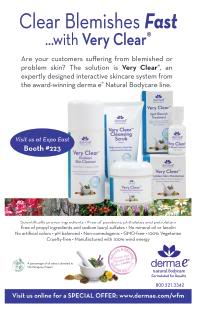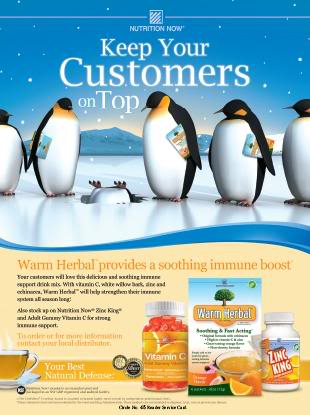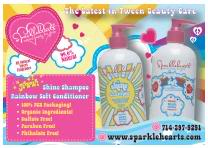It might be easier to predict the movement of the stock market than to anticipate the moods of teenagers. In a matter of an afternoon, their characters may change from silly to sullen, from needing a hug to wanting solitude. But, one thing is for sure. Their growing bodies desperately need great nutrition.
During their teenage years, childreen start making decisions about their bodies. Often what they select to put in their mouths isn’t pretty. Says Marci Clow, MS, RD, senior director of product research with Rainbow Light Nutritional Systems, Santa Cruz, CA, “Total nutrient needs are greater during the adolescent/teen years than at any other time of life (except for pregnancy and lactation) and teenagers don’t always make the right food choices to deliver optimum nutrition. There is a huge variation in potential range/differentiation of intakes for this population group.”
Therefore, retailers should think about how to approach this portion of their clientele, many of whom are very accepting of natural products—but highly susceptible to the negative lifestyle temptations surrounding them.
Teeny-Weeny Supplements
Marketers of junk food inundate kids with mixed messages that sugar water is healthy because it’s made with fruit, that canned pasta offers all the vegetables you need for the day and that chocolate milk is a health food.
This jungle of advertising traps can be hard for teens to navigate. Says Jennifer Hansgate, director of educational information resources at Enzymatic Therapies, Green Bay, WI, “During the rapid growth of puberty, the body has an increased need for calories and key nutrients including protein, calcium, iron, folate and zinc. However, hanging around with friends, frequenting fast food outlets and snacking can lead to excessive intake of fat, sugar and calories and an insufficient intake of important vitamins and minerals.”
Such poor choices not only affect health; it can even affect performance at school.
Staying sharp at school. While teens may be apt to reach for their caffeine fix to keep sharp in history class, they should instead consider if the food they’re scarfing down at lunch is offering the nutrition they need to positively affect their behavior and concentration. For example, poor food choices may cause restlessness, inattentiveness, sleepiness and even a bad memory, experts say.
Parents of teens and tweens should be alerted that good nutrition can help. For example, the B vitamins help food break down into energy. According to Kate Jones, president of Nutrition Now, Vancouver, WA, “Research suggests B-complex vitamins, specifically folic acid, vitamin B6 and vitamin B12, play an important role for the nerves and brain health.” It’s especially vital for vegetarian youth to take vitamin B12 supplements, as they may not get enough from their diet alone.
|
Select Supplements for Teens and Tweens ALL ONE/Nutritech’s ALL ONE Original Formula is suitable for teens. Enzymatic Therapies offers Doctor’s Choice for Female Teens, Doctor’s Choice for Male Teens and Derma Klear Akne Treatment. Michael’s Naturopathic Programs has supplements for pre-teen boys, pre-teen girls and teens. Nelson’s Bach and Rescue products (such as Rescue Sleep and Bach Kids Confidence Remedy) are appropriate for teens. Nutrition Now offers B Complex Adult Gummy Vitamins, Rhino Omega-3 Gummy Vitamins, Rhino Chewy C + Zinc & Echinacea/Zinc King, Vitamin D Adult Gummy Vitamins, Rhino Swirlin’ Calci-Bears + Vitamin D. Rainbow Light Nutritional Systems offers Active Health Teen Multivitamin, a food-based multivitamin to address specific nutritional needs with support for energy, stress, mood and effective skin-clearing action. |
Other “brain foods” include omega-3s, which many experts say may benefit children with attention deficit hyperactivity disorder (ADHD) and other concentration problems. Says Jones, “Omega-3s can also stabilize mood as they have been shown to increase the levels of serotonin in the brain (a neurotransmitter that regulates mood). “
Basic minerals also may have a link with school performance. “A recent study in the U.S. Agricultural Research Service’s Grand Forks Human Nutrition Research Center showed that 7th grade students who took 20 mg of zinc five days a week for a 10- to 12-week period performed better in attentiveness, memory, problem-solving and hand-eye coordination than those who did not.” If teens aren’t eating enough legumes, whole grains (and fortified cereals) as well as dairy products, they may not be getting enough zinc. And vegetarian teens may need a boost from supplementation as lean red meat is a good source of zinc.
Also linked to these food sources is iron; not surprisingly, iron deficiency may cause sluggishness and sleepiness. Says Jones, “Too little iron leads to low blood levels, which makes it harder for the brain to get the necessary oxygen.” She also points out that getting enough vitamin C helps with iron absorption.
As a bonus, teens and tweens can benefit from vitamin C, zinc, iron, and other minerals for a healthy immune system—which keeps them out of the sick ward and on track with their busy schedules. Adds Hansgate, “[Vitamin C] also has antioxidant activity and assists with hormone synthesis,” which clearly is important during the teen years. “Teens are susceptible to deficiency of these nutrients as they often have nutrient deficient diets containing way too much sugar and processed foods and their bodies are working on overtime, needing all the nutrition they can get for growing and maturing.”
Strong and healthy bones. As much as they may not want to hear it, teens and tweens still have a lot of growing up to do (literally). When they swap out milk for soda and juice (and spend more time playing video games than exercising), these youngsters aren’t doing enough to support strong, growing bones. Perhaps this is why more girls and boys fracture their bones than children did a generation ago, according to the Dairy Council of California (1). In fact, fracture incidence rates have grown by one-third in boys and one-half in girls.
The council explains that getting enough calcium and physical activity are two of the most important ways to build bone density and avoid fractures. Hansgate adds another element to the mix: prevention of decreased bone density later in life. “There is a limited time window to deposit calcium into bone. According to the National Osteoporosis Foundation, approximately 85–90% of adult bone mass is acquired by age 18 in girls and 20 in boys,” she says. Extra calcium and magnesium are needed for bone health support, says Hansgate. “Currently, the American diet contains, on average, only 250 mg of magnesium per day, less than the Recommended Dietary Allowance (RDA) of 420 mg for men and 320 mg for women,” she says (2, 3). And, as Jones points out, just 12% of girls and 32% of boys (ages 12–19) get enough calcium.
New research also shows that another important bone-support aid is often lacking in teens. One in seven teens in the United States is vitamin D deficient, according to a 2009 Pediatrics article (4). Since vitamin D aids calcium absorption and bone mineralization, the growing teenage years are no time to be without this vitamin.
Other data released around the same time indicate that teens who don’t get enough vitamin D are also at increased risk of obesity. A study from the Medical College of Georgia found teens that had high levels of vitamin D in their diets also had less abdominal fat. The reverse was true of those who had little vitamin D in their diet (5).
 So, be sure teens are aware of the need to take these important bone-support supplements if they don’t get enough in their diet.
So, be sure teens are aware of the need to take these important bone-support supplements if they don’t get enough in their diet.
Reproductive health. Certain nutrients can be particularly beneficial during puberty. Says Hansgate, “Adolescent boys suffer more from occasional acne because of the changing levels of male hormones. Sexual maturation increases male teens’ need for zinc, which is involved in the immune system and the male sex glands. Male teens generally don’t require supplemental iron, so they should not generally take supplemental iron unless advised to do so by their healthcare practitioner.”
On the girls’ side, once menstruation begins, females are susceptible to iron deficiency and must be sure they get enough of this mineral via diet and/or supplementation. Also, to address hormonal changes that cause mood fluctuations, Clow points out that the vitamin B-complex and hormone-balancing herbs like vitex “have been shown to help with mood swings, including those related to premenstrual syndrome in females.”
Mood support. Most parents agree that teens and moodiness are practically synonymous. Can supplementation help? “Yes and no,” says Michael Schwartz, president of Michael’s Naturopathic Programs, San Antonio, TX. On the yes side, “Fixing the adrenal glands will in most cases alleviate depression especially when connected to low blood sugar.”
Also commenting on the low blood sugar link is Julie Tomlinson, sales and marketing manager for ALL ONE/Nutritech, Santa Barbara, CA. “Many times, mood fluctuations can be attributed to blood sugar imbalances and poor nutrition, so the first approach should be to include a balanced multivitamin and mineral and look at refined carbohydrate intake. Once those items are addressed and still no improvement is seen, only then should other supplements or alternative approaches be considered,” she says.
But, if a parent speaks to you about a child that is habitually down in the dumps, recommend they talk with their healthcare provider.
 Getting teens to take supplements. Getting teens to commit to taking supplements every day can be tricky. Simplicity may be the most important element of a teen’s supplement program. Says Tomlinson, “Individual supplementation of certain nutrients could actually cause more problems then help, creating imbalance in a nutrient balance that is already being taxed. Nutrients such as the B vitamins compete for absorption, so an unbalanced ratio can cause a deficiency. The minerals iron, copper and zinc also compete for absorption sites, so high levels of zinc intake can actually result in anemia (iron deficiency).” Therefore, combination products and teen-specific multiples may help compliance in this age group.
Getting teens to take supplements. Getting teens to commit to taking supplements every day can be tricky. Simplicity may be the most important element of a teen’s supplement program. Says Tomlinson, “Individual supplementation of certain nutrients could actually cause more problems then help, creating imbalance in a nutrient balance that is already being taxed. Nutrients such as the B vitamins compete for absorption, so an unbalanced ratio can cause a deficiency. The minerals iron, copper and zinc also compete for absorption sites, so high levels of zinc intake can actually result in anemia (iron deficiency).” Therefore, combination products and teen-specific multiples may help compliance in this age group.
Rainbow Light developed a unique method for gaining compliance: a multivitamin with a flexi-dose option to meet varying needs of teens and tweens. “This formula is designed so teens can take from one to three tablets, depending on the quality of their diet and the health of their skin,” Clow explains. She adds that the skin health element is particularly important for teens and compliance. “Teenagers may not be overly concerned about protecting their long-term health with a multivitamin, but they are very interested in maintaining or achieving a good, clear complexion,” she says.
Clearly Great Skin
Getting their first pimple is a rude awakening that teens must kiss goodbye the haven of clear childhood skin. But, savvy retailers can use this right of passage as an excuse to offer teen-friendly education in the form of a youth-specific store tour or educational seminar about natural ingredients that are particularly beneficial for this age group. While teens may want to hear about quick fixes for their skin woes in 50 words or less, it’s important for them to hear about what’s going on behind the scenes of pubescent skin.
Problematic skin during the teenage years is often caused by a combination of genetic and lifestyle issues, says Wendy Lucas, vice president of marketing at Desert Essence, Valencia, CA, which include hormonal imbalances and too much sebum. This oily substance is secreted by pores to lubricate the skin, but production kicks into overtime during times of hormonal changes (like puberty). Ironically, Lucas points out that excess oil production can also be cause by over-cleansing the skin, especially with harsh products. To make matters worse, dead skin cells can clog pores, trap in bacteria, cause redness, swelling and pimples. The situation is compounded by a poor diet. “Poor eating habits may result in not eating enough skin-healthy food,” says Lucas.
Therefore, teens should be taught to fight oil overproduction and dead skin cells with natural skincare products. Says Grace Petrarca, C.A.P., and co-founder Good For You Girls, New Hartford, CT, “Traditional OTC drug store acne products contain benzyl peroxide as their main acne-fighting ingredient. This harsh chemical is known to strip the skin and can cause dryness and irritation to already inflamed effected tissues.”
Adds Kim Grustas, co-founder of Good For You Girls, “There is a misconception that acne treatments must burn in order to work. Sure, if you put acid on delicate facial skin tissue it will get rid of bacteria, but it will also leave a wake of irritated tissue in its path that will take longer to heal then perhaps the blemish you were trying to treat in the first place.”
Luckily, the natural products industry has much to offer teens and tweens. Says Curt Finckler, senior brand manager of Nelsons Homeopathy, North Andover, MA, “there are several excellent acne care options available, many of which can be purchased at local natural product stores at an affordable price. Homeopathy is an up–and-coming all-natural medicine that should be considered for such skin care issues. The modality approaches acne care from an internal and external approach, recognizing the role of holistic care on general skin health.”
One natural pimple fighter that is well suited for teens is tea tree oil, which Lucas calls a “perfect product” for oily or troubled skin. She explains that this natural antiseptic is “well known for its deep-cleansing properties,” but unlike traditional acne products, “it helps reduce redness and treats without any dryness or flaking.”
A landmark study from Australia showed that a 5% tea tree oil gel worked as well as a 5% benzyl peroxide lotion for reducing mild to moderate acne. And, patients experienced fewer side effects from the natural product (6).
Lucas offers a suggestion for how to use this product: “To best treat problem skin, clean your face twice a day. Use a gentle scrub once a week and spot treat with a tea tree-based product as needed.”
Several other natural ingredients can be beneficial for blemish-prone skin as well, says Linda Miles, L. Ac., D.O.M., vice president of derma e Natural Bodycare, Simi Valley, CA.
- Willow bark is a natural source of salicylic acid that “helps remove dead skin tissue, unclog pores and make the removal of debris and toxins possible,” Miles states, pointing out that this ingredient also can gently make greasy skin less oily.
- Also for oil control, rosewood “helps reduce sebum production, stimulate new skin cell growth and balance both dry and oily skin,” says Miles.
 Lavender has antiseptic and antifungal agents that may help fight infections that cause pimples. Miles adds, “It also accelerates the healing of skin cells and helps rejuvenate the skin after breakouts and flare-ups occur.” Suzanne Dean, vice president and co-founder of Tea Tree Therapy, Inc., Ventura, CA, makes the point that lavender, when combined with other antiseptics like tea tree oil, can be especially helpful without doing any harm to the skin. She explains that her company’s tea tree and lavender solution “will cleanse and kill bacteria whilst drying up the area usually within a day or two without harming surrounding skin tissue. The pH is neutral in the [solution, thus] keeping the acid mantle balanced.”
Lavender has antiseptic and antifungal agents that may help fight infections that cause pimples. Miles adds, “It also accelerates the healing of skin cells and helps rejuvenate the skin after breakouts and flare-ups occur.” Suzanne Dean, vice president and co-founder of Tea Tree Therapy, Inc., Ventura, CA, makes the point that lavender, when combined with other antiseptics like tea tree oil, can be especially helpful without doing any harm to the skin. She explains that her company’s tea tree and lavender solution “will cleanse and kill bacteria whilst drying up the area usually within a day or two without harming surrounding skin tissue. The pH is neutral in the [solution, thus] keeping the acid mantle balanced.”
- Last, chamomile is well known for its soothing and anti-inflammatory properties. This ingredient may help reduce redness, sensitivity and irritation, according to Miles.
Petrarca agrees with Miles that chamomile and lavender offer great benefits for teen skin. She explains that these anti-inflammatory botanicals (plus others like calendula) “help sooth the deepest layers of the skin for repair and renewal. This is all done without harsh chemicals and has a beautiful result for young skin.”
She adds another important ingredient to the mix of tween/teen-friendly skin aids: “Meadowsweet extract, a powerful botanical that targets active acne by cleaning out the bacteria from the pores.”
Kristine Carey, director of marketing for MyChelle Dermaceuticals, Louisville, CO, says her company is using a unique product in its Clear Skin Teen line: “Super-critical totarol is a key ingredient in most of the products featured in MyChelle’s new teen acne line…Totarol is a naturally occurring plant extract, from Totara trees in New Zealand, which is a potent antibacterial and antioxidant property in the skin care series.” Other ingredients include daisy (for brightening scar tissue), willow herb, rooibos (for soothing and repairing skin), zinc sulfate (an astringent), neem (to prevent the spread of infectious material associated with acne) and lemongrass (to normalize oil production and stimulate cell regeneration).
Talking Teen
Tweens and teens are just starting to experiment with cosmetics and skincare products for the first time. With this in mind, retailers have a responsibility to cherry pick teen-friendly products that are appealing to young shoppers.
One thing to keep in mind is the benefit that may be specific to teens. “Are they looking to clear blemishes or maintain soft, smooth and younger-looking skin?” asks Miles. And, make sure the product delivers an appreciable amount of effective, data-backed ingredients. Most teens and tweens have little patience for products that don’t deliver results they can see.
Next, tweens and teens will be drawn to products that offer that little something extra. Says Hilary Orr, co-owner of Sparklehearts, Huntington Beach, CA. “[Our] mission is to make natural fun and to encourage tweens to make healthy choices regarding what they are putting onto their skin.”
To do this, the company plays up the “glam factor” in products and on the packaging. For example, the firm’s Sweet Hearts Sparkly Body Lotion is formulated with all-natural mica sparkles, “which produce amazing shimmer to the body,” says Orr. The product also incorporates beneficial and sweet-smelling ingredients like sesame oil, sweet almond oil and murumuru butter. “Smelling great is also a priority to tweens,” she explains.
Lucas agrees that scent sells with teens and tweens. “Desert Essence Organics is a great line for teens as the products are really delicious feeling and smelling (something teens and tweens typically love). However these delicious products don’t come at a chemical cost. They are free of parabens, SLS, sulfates, phthalates, artificial colors and fragrances, silicones, EDTA, glycol and petroleum based ingredients. They are also 100% vegan, wheat and gluten free.”
One last pointer is that teen and tween products should be quick and simple to use. To help on this front, many companies have developed skincare systems that eliminate the guesswork of pairing appropriate products. Since many youngsters in the age group are brand-loyal shoppers, this may also encourage repeat purchasing.
Examples of such product lines from companies interviewed for this article are:
- derma e’s Very Clear skincare system includes a problem skin cleanser, cleansing scrub, spot blemish treatment and problem skin moisturizer to help rebalance skin. Young shoppers may also like the Fruit Smoothees line, intended “to protect skin from the first visible signs of aging.”
- Desert Essence offers Thoroughly Clean Face Wash, Tea Tree Cleansing Pads and Blemish Touch Stick for problem skin.
- Intended for girls ages nine through 14, Good For You Girls offers a skincare kit that contains a cleanser, toner and moisturizer. This fall, the company will offer individual sizes of these products as well as introduce a blemish wash and body products.
- New from MyChelle Dermaceuticals is the Clear Skin Teen Anthology, which includes Clear Skin Balancing Cream, Clear Skin Clarifying Pads, Clear Skin Cleanser and Clear Skin Spot Treatment. The firm also has a mineral makeup line that is suitable for teens.
- Nelsons Homeopathy offers a complete, four-step homeopathic acne care line of products (called Nelsons Pure & Clear) that includes a facial wash, a toner, a moisturizer and treatment products.
- The Sparklehearts’ Natural Beauty For Girls line includes Shine Shampoo, Rainbow Soft Conditioner, Bubbling Blooms Body Wash, Peace Out/No Knots Hair Detangler and Sweet Hearts Sparkly Body Lotion. The company is currently in the process of formulating an all-natural lip gloss and deodorant.
- Tea Tree Therapy offers a line of skincare products that incorporate tea tree oil. WF
References
- Dairy Council of California, “Kids and Teens Fractures,” www.dairycouncilofca.org/Milk-Dairy/Milk_Bones.aspx, accessed August 1, 2009.
- R.K. Rude and H.E. Gruber, “Magnesium Deficiency and Osteoporosis: Animal and Human Observations,” J. Nutr. Biochem. 15, 710–716 (2004).
- J.W. Nieves “Osteoporosis: The Role of Micronutrients,” Am. J. Clin. Nutr. 81, 1232S–1239S (2005).
- New York- Presbyterian Hospital/Weill Cornell Medical Center/Weill Cornell Medical College, “One In Seven U.S. Teens Is Vitamin D Deficient,” press release, March 12, 2009.
- Medical College of Georgia, “Not Enough Vitamin D In The Diet Could Mean Too Much Fat On Adolescents,” March 16, 2009.
- D.L. Pannowitz and R.S. Barnetson, “A Comparative Study of Tea-Tree Oil versus Benzyl Peroxide in the Treatment of Acne,” Med. J. Aust. 153 (8), 455–458 (1990).
Published in WholeFoods Magazine, Sept. 2009











